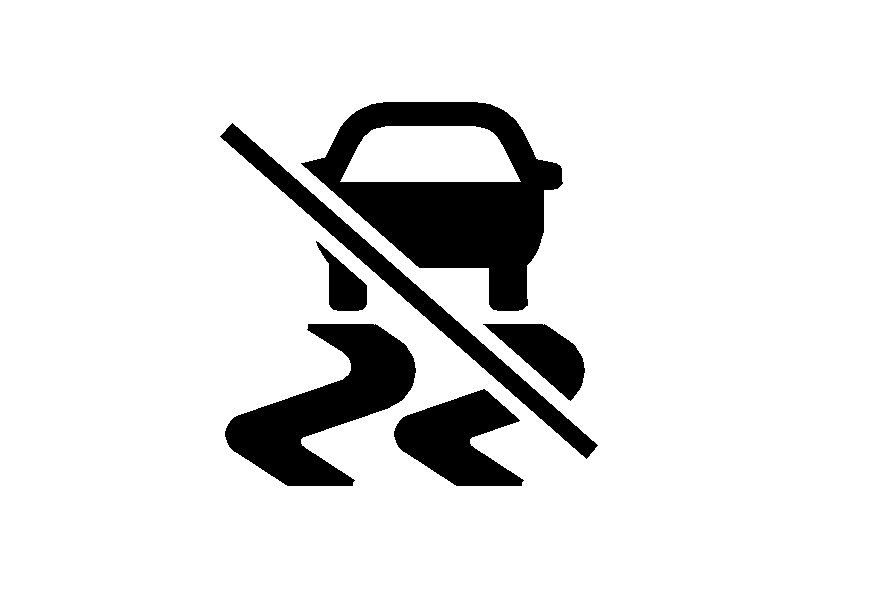Your vehicle may have an Electronic Stability Control (ESC) system which combines antilock brake, traction and stability control systems and helps the driver maintain directional control of the vehicle in most driving conditions.
When you first start your vehicle and begin to drive away, the system performs several diagnostic checks to ensure there are no problems. You may hear or feel the system working. This is normal and does not mean there is a problem with your vehicle. The system should initialize before the vehicle reaches 20 mph (32 km/h). In some cases, it may take approximately two miles of driving before the system initializes.

The ESC light is located on the instrument panel cluster.
If the system fails to turn on or activate, the ESC light will be on solid, and the ESC OFF or SERVICE ESC message will be displayed in the DIC. If the vehicle has gone through heavy acceleration or braking during the first two miles after starting your vehicle, these messages and the ESC light may also appear. If this is the case, your vehicle does not need servicing. Turn your vehicle off and back on again to reset the system. If the SERVICE ESC message appears on the Driver Information Center (DIC), and your vehicle hasn't gone through hard acceleration or braking in the first two miles, your vehicle should be taken in for service.
When the ESC off light is on and either the SERVICE ESC or ESC OFF message is displayed, the system will not assist the driver to maintain directional control of the vehicle. Adjust your driving accordingly. See DIC Warnings and Messages
The traction control part of ESC can be turned off or back on by pressing the ESC button. To disable both traction control and ESC, press and hold the button briefly.
When the system is turned off, the TRACTION OFF message will first appear followed by the ESC OFF message. The ESC OFF and TCS OFF indicator lights will also appear to warn the driver that both traction control and ESC are disabled.
It is recommended to leave the system on for normal driving conditions, but it may be necessary to turn the system off if your vehicle is stuck in sand, mud, ice or snow, and you want to "rock" your vehicle to attempt to free it. It may also be necessary to turn off the system when driving in extreme off-road conditions where high wheel spin is required. See If Your Vehicle is Stuck in Sand, Mud, Ice, or Snow .
ESC may also turn off automatically if it determines that a problem exists with the system. The ESC OFF and SERVICE ESC messages and the ESC OFF light will be on solid to warn the driver that ESC is disabled and requires service. If the problem does not clear itself after restarting the vehicle, you should see your retailer for service. See DIC Warnings and Messages
Adding non-dealer/non-retailer accessories can affect your vehicle's performance. See Accessories and Modifications
Traction Control Operation
The traction control system is part of the ESC system. Traction control limits wheel spin by reducing engine power to the wheels (engine speed management) and by applying brakes to each individual wheel (brake-traction control) as necessary.
The traction control system is enabled automatically when you start your vehicle, and it will activate and display the LOW TRACTION message if it senses that any of the wheels are spinning or beginning to lose traction while driving. If you turn off traction control, the TCS OFF warning light will come on and the TRACTION OFF message will be displayed The ESC system will remain operational unless it is turned off. For more information on the traction active message, see Driver Information Center (DIC) .
Notice: If you allow the wheel(s) of one axle to spin excessively while the ESC, ABS and brake warning lights and the SERVICE ESC message are displayed, you could damage the transfer case. The repairs would not be covered by your warranty. Reduce engine power and do not spin the wheel(s) excessively while these lights and this message are displayed.
The traction control system may activate on dry or rough roads or under conditions such as heavy acceleration while turning or abrupt upshifts/downshifts of the transmission. When this happens, you may notice a reduction in acceleration, or may hear a noise or vibration. This is normal.
If your vehicle is in cruise control when the system activates, the ESC ACTIVE message will appear and the cruise control will automatically disengage. When road conditions allow you to use cruise again, you may re-engage the cruise control. See Cruise Control .
ESC may also turn off automatically if it determines that a problem exists with the system. If the problem does not clear itself after restarting the vehicle, you should see your retailer for service.
Adding non-dealer/non-retailer accessories can affect your vehicle's performance. See Accessories and Modifications for more information.
